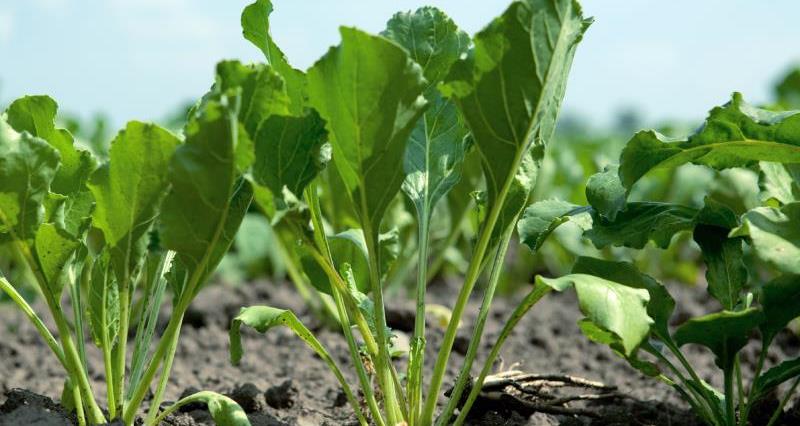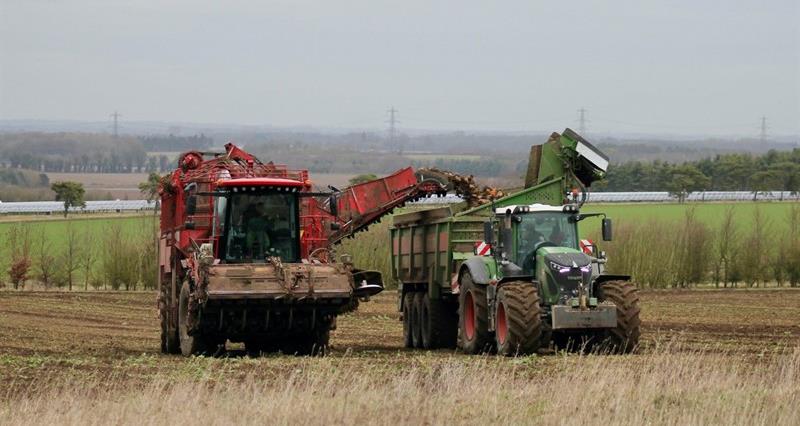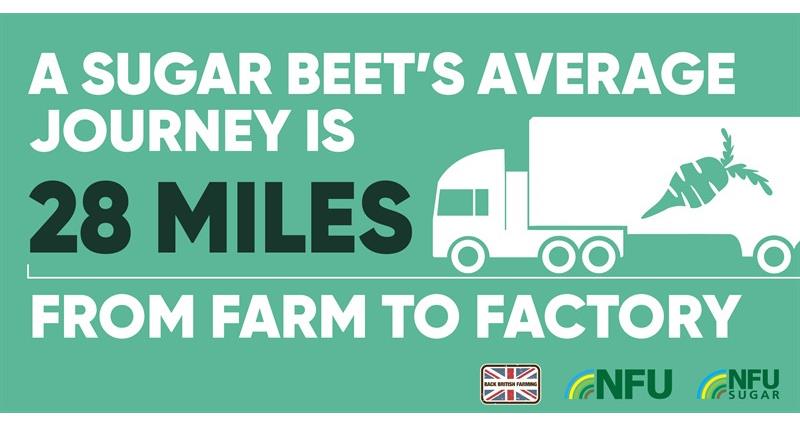On this page
- Sugar beet and net zero
- Read our net zero case study
- Reply to our call for net zero volunteers
- Sugar beet and waste
Learn about sugar beet and net zero ambition
Sugar beet is a crop with a good story to tell, but there are improvements that can be made.
Carbon dioxide: Carbon dioxide (CO2) is the most commonly produced greenhouse gas (GHG). Carbon sequestration is the process of capturing and storing atmospheric carbon dioxide. It is one method of reducing the amount of CO2 in the atmosphere with the goal of reducing global climate change.
Nitrous oxide: Nitrous oxide (N2O) is a powerful and long-lived GHG with a global warming potential 298 times that of carbon dioxide (CO2) according to the IPCC. Emissions of N2O from agricultural systems are largely associated with the use of nitrogen (N) fertilisers and manures.
Sugar beet strengths
- Sugar beet sequesters carbon dioxide (see above for definition)
- It has low nitrogen requirements, reducing nitrous oxide emissions (see above for definition)
- Average distance from field to factory is just 28 miles resulting in low food miles and CO2 footprint
- Virtually zero waste (less than 200 grams of waste for every tonne of sugar produced) resulting in no waste to landfill
Sugar beet challenges
- Energy-intensive processing
- Heavy cultivation equipment resulting in soil compaction
- Nitrous oxide emissions from artificial fertiliser application
Sources of emissions
Approximately 51% of sugar beet production emissions come from processing, 30% from cultivation (on-farm), 15% from animal feed and 4% from transportation (Carbon Trust, 2020).

- Processing. Of the processing emissions, the vast majority are caused by fuels – natural gas, coal, gas oil and biogas). If British Sugar switched to using electric machinery and vehicles and used energy from renewable sources, it could drastically cut the processing plant emissions. Even switching to electricity from the grid would reduce emissions, as the emission factor from the UK electricity grid has become less than the electricity produced by British Sugar’s CHP plant within the last five years.
- Cultivation. Most emissions in this category stem from fertilisers, either from N fertiliser manufacture or emissions from soil. Reducing or avoiding using fertilisers in the field would lower the overall emissions footprint of sugar beet.
Breaking down emission sources
- Scope 1 covers direct emissions from owned or controlled sources (British Sugar factories)
- Scope 2 covers indirect emissions from the generation of purchased electricity, steam, heating and cooling consumed by the reporting company (British Sugar energy consumption and sources)
- Scope 3 includes all other indirect emissions that occur in a company's value chain (emissions from cultivation, ie., on-farm emissions)
Food manufacturers are focusing on scope 3 emissions to meet their own net zero goals and are also increasingly interested in supporting farmers directly to achieve their goals. For example, we know that companies that source homegrown sugar have approached British Sugar regarding their scope 1 and 2 emissions, and at the same time have contacted NFU Sugar about scope 3 emissions.
How can improvements be made?
From the point of view of a company that sources homegrown sugar, there are three ways to deliver a lower on-farm climate impact for sugar beet:
- Specific: Cutting beet GHGs (eg. reduced N use)
- Holistic: Sourcing from 'climate friendly' growers (eg. whole farm GHG benchmarked)
- Offset: Sourcing from farms that sequester carbon (eg. tree planting, soil carbon increase)
The standout reductions are based around N use. It is vital that companies recognise that every farm is different as not every action will be appropriate for every farm.
- Reduce use of Artificial N fertiliser through using alternatives, variable rate software/precision farming techniques.
- Reduce soil carbon loss through the use of low ground pressure tyres, min-till or use of cover crops.
- Increase carbon sequestration through an increase in permanent grass, tree cover or measurable soil carbon increases.
Opportunities
Key opportunities lie in the carbon market income from government (ELMs) or private finance (see scope 3 emissions, above). New breeding techniques such as gene editing provide the opportunity to increase productivity while using fewer inputs. NFU Sugar continues to lobby government about the benefits that gene editing can bring to the homegrown sugar industry, including reducing carbon emissions (alongside wider productivity gains).
Read our net zero case study
NFU Sugar board member Tom Clarke recently featured in the NFU Doing our bit for net zero report. He said:
“The changes I’ve made on the farm so far have come about from me just thinking about what we were doing and making positive change. I have focused on reducing inputs, improving productivity, and reducing emissions. For example, I now put zero nitrogen fertiliser on my sugar beet, reducing costs and emissions.
Although I am fortunate to farm on soil that allows me to implement strategies like this, I believe everyone can make a difference by starting small. Climate change is a significant challenge, which is why I volunteered to represent the Sugar Board on the NFU’s net zero steering group.”
Tom’s case study focuses on carbon storage, highlighting what he is doing on farm to contribute to agriculture’s net zero by 2040 target. This includes:
- Moving 75% less soil than previously, so now only ploughing regularly before potatoes. Experimenting with min/no-till for wheat
- Upgraded beet drill, meaning less soil disturbance at drilling and more beet lifted in February and March, missing the riskiest of winter weather
- Choosing over-wintered stubble HLS option to protect soils, but implemented on greater acreage
- ‘Nurse’ crop of barley drilled ahead of sugar beet to reduce wind erosion and beet tops retained to return organic matter to soil
Read Tom’s case study and the other 25 case studies that make up the report.
Call for volunteers
If you are taking action towards reaching net zero and would like to feature as a sugar beet case study, please get in touch by emailing nfusugar@nfu.org.uk.
More from NFUonline:
- Report: Achieving net zero NFU unveils its plan for British farming to deliver net zero
- Achieving net zero - meeting the climate change challenge
- NFU report: The Future of Food 2020
Sugar beet and waste
Waste is low in the sugar beet industry. Read on to find out how growers minimise it.
The benefits of in-field waste
Sugar beet tops comprise of sugar beet leaves, or a mixture of the leaves and crowns, depending on the harvesting machinery used. Sugar beet leaves normally contain 12%–14% dry matter, and leaves and crowns together contain approximately 16%–18% dry matter.
It is standard practice to incorporate the tops and leaves into the soil, and NFU Sugar is working to understand the carbon benefits of this practice as it is part of the good story that sugar beet has to tell.
Suiker Unie, a Royal Cosun Company, has started producing protein from sugar beet foliage. The process is a unique method that the Dutch company has exclusive rights to. It makes use of the 1-3% protein content in green plant leaves and will eventually be used for plant leaves other than sugar beet.
The business flags that plant protein sources will be essential to produce enough proteins to feed the growing world population and expects the first products made with the protein to be on the market by 2022.
Learn more in this Cosun video, Green Protein: from sugar beet leaves to protein.
Co-products
Sugar beet processing results in virtually zero waste (less than 200 grams of waste for every tonne of sugar produced) by turning process outputs into inputs for a wide range of products. For example, topsoil for landscaping, aggregate for building, animal feed, limex and electricity for the national grid.
The below provides an indication of what co-products are produced.
Aggregate
About 4,800 tonnes of stones are received with the sugar beet crop every year. A proportion of these are recovered and graded, before being marketed for civil engineering, road building and construction projects.
Topsoil
Each year, British Sugar receives around 200,000 tonnes of soil along with the eight million tonnes of sugar beet it purchases from UK growers. This soil is recovered and marketed under the British Sugar brand Topsoil and sold primarily into the landscaping and amenity industries.
Animal feed
After extracting the sugar from sugar beet, the pulp is pressed to generate over 500,000 tonnes of high-quality animal feed. Supplied to the livestock industry by Trident Feeds, a subsidiary of British Sugar since 1985, this feed is produced in accordance with stringent feed assurance standards and provides a useful energy food for a wide range of livestock including, cattle, sheep, pigs, goats and horses.
Electricity
Advanced manufacturing plants use a power generation system, producing both steam and electricity, called combined heat and power (CHP), recognised as one of the most fuel-efficient processes available. Coal, oil or gas-fuel water boilers produce steam at high pressure, which then drives turbo-alternators generating electricity to power British Sugar factories.
The steam from the turbo-alternator is also used at various other stages of the sugar manufacturing process. Excess electricity is sold to electricity supply companies.
Developing this principle further, high-performance combined-cycle gas turbines have been installed at the Bury St Edmunds and Wissington factories, efficiently generating even more electricity for sale.
Soil conditioning (Limex)
British Sugar is the largest supplier of liming products to UK agriculture. Each year approximately 300,000 tonnes of liming product is made at the factories as a co-product of the sugar manufacturing process and marketed under the Limex brand. Limex provides a sustainable option to amend soil pH and increase available calcium.
It significantly reduces the volume of limestone and chalk that would otherwise be quarried and crushed for agriculture and other lime markets, supporting the UK government’s objective to encourage re-use of co-products.
Renewable energy
In 2016, British Sugar invested £15 million in a new anaerobic digestion plant at the Bury St Edmunds site. Using the pressed sugar beet pulp, which is produced alongside the sugar-making process, enables the break down of microorganisms into biodegradable material, with one of the end products being biogas. Methane generated from the biogas is fed into a combined heat and power (CHP) plant, generating green electricity.
The plant is expected to use around 97,000 tonnes of pressed pulp each year and export 38GWh of electricity to the national grid, contributing to the UK’s renewable energy targets under the Renewable Energy Directive. In addition to electricity, the operation will also create digestate, which will be used in the local farming area for both soil conditioning and fertiliser replacement.
Bioethanol
In 2007, British Sugar was the first company to manufacture bioethanol in the UK, and it has since produced up to 64,000 tonnes (80 million litres) of bioethanol every year. It is able to trace the full lifecycle of bioethanol, demonstrating the whole process of production, including crop growing, fermentation and distribution, to ensure genuine environmental benefits are delivered.
Horticulture
Partnering with GW Pharmaceuticals, British Sugar's horticultural business grows a key ingredient for the pharmaceutical company.
Glasshouses benefit from their location close to the sugar factory and more than 240 miles of piping carries hot water from the factory all year round to maintain temperatures that suit the plants.





